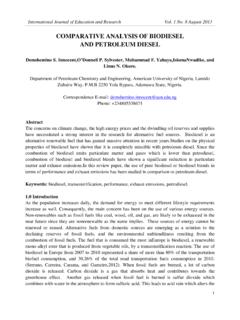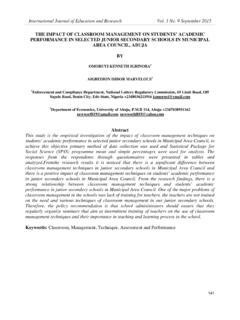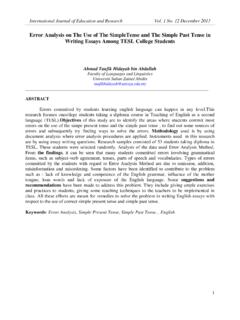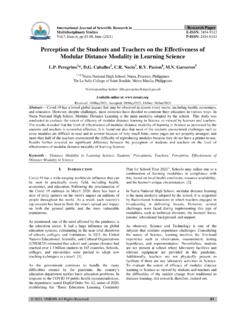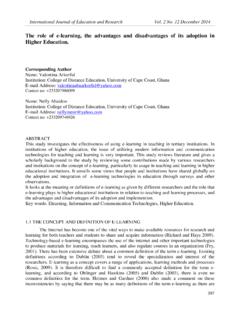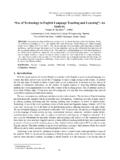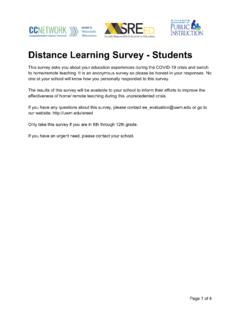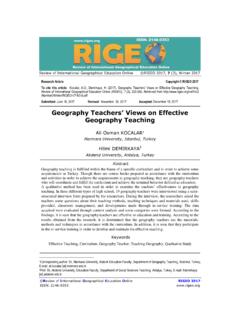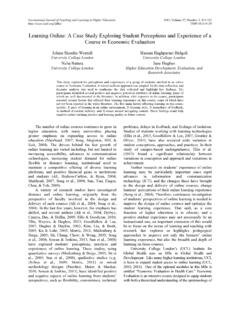Transcription of The role of e-learning, the advantages and disadvantages ...
1 International Journal of Education and Research Vol. 2 No. 12 December 2014. The role of e- learning , the advantages and disadvantages of its adoption in Higher Education. Corresponding Author Name: Valentina Arkorful Institution: College of distance Education, University of Cape Coast, Ghana E-mail Address: Contact no: +233207986099. Name: Nelly Abaidoo Institution: College of distance Education, University of Cape Coast, Ghana E-mail Address: Contact no: +233209746926. ABSTRACT. This study investigates the effectiveness of using e- learning in teaching in tertiary institutions. In institutions of higher education, the issue of utilizing modern information and communication technologies for teaching and learning is very important. This study reviews literature and gives a scholarly background to the study by reviewing some contributions made by various researchers and institutions on the concept of e- learning , particularly its usage in teaching and learning in higher educational institutions.
2 It unveils some views that people and institutions have shared globally on the adoption and integration of e- learning technologies in education through surveys and other observations. It looks at the meaning or definitions of e- learning as given by different researchers and the role that e- learning plays in higher educational institutions in relation to teaching and learning processes, and the advantages and disadvantages of its adoption and implemention. Key words: Elearning, Information and Communication Technologies, Higher Education. THE CONCEPT AND DEFINITION OF E- learning . The Internet has become one of the vital ways to make available resources for research and learning for both teachers and students to share and acquire information (Richard and Haya 2009). Technology-based e- learning encompasses the use of the internet and other important technologies to produce materials for learning , teach learners, and also regulate courses in an organization (Fry, 2001).
3 There has been extensive debate about a common definition of the term e- learning . Existing definitions according to Dublin (2003) tend to reveal the specialization and interest of the researchers. E- learning as a concept covers a range of applications, learning methods and processes (Rossi, 2009). It is therefore difficult to find a commonly accepted definition for the term e- learning , and according to Oblinger and Hawkins (2005) and Dublin (2003), there is even no common definition for the term. Holmes and Gardner (2006) also made a comment on these inconsistencies by saying that there may be as many definitions of the term e- learning as there are 397. ISSN: 2201-6333 (Print) ISSN: 2201-6740 (Online) academic papers on the subject Dublin (2003) in trying to find a common meaning of the term e- learning went on to ask the following questions: Is e- learning an on-line coursework for students at a distance ? Does it mean using a virtual learning environment to support the provision of campus- based education?
4 Does it refer to an on-line tool to enrich, extend and enhance collaboration? OR is it a totally on-line learning or part of blended learning ? (Dublin, 2005). Some of the definitions of the term e- learning as given by different researchers and institutions are reviewed below. In some definitions e- learning encompasses more than just the offering of wholly on-line courses. For instance Oblinger and Hawkins (2005) noted that e- learning has transformed from a fully-online course to using technology to deliver part or all of a course independent of permanent time and place. Also the European Commission (2001) describes, e- learning as the use of new multimedia technologies and the Internet to increase learning quality by easing access to facilities and services as well as distant exchanges and collaboration. The following are also different definitions of e- learning . E- learning refers to the use of information and communication technologies to enable the access to online learning /teaching resources.
5 In its broadest sense, Abbad et al (2009), defined E- learning to mean any learning that is enabled electronically. They however narrowed this definition down to mean learning that is empowered by the use of digital technologies. This definition is further narrowed by some researchers as any learning that is internet-enabled or web-based (LaRose et al, 1998; Keller and Cernerud, 2002). According to Maltz et al (2005), the term e- learning ' is applied in different perspectives, including distributed learning , online- distance learning , as well as hybrid learning . E- learning , according to OECD (2005) is defined as the use of information and communication technologies in diverse processes of education to support and enhance learning in institutions of higher education, and includes the usage of information and communication technology as a complement to traditional classrooms, online learning or mixing the two modes. Also according to Wentling et al (2000) the term e- learning refers to the attainment and use of knowledge that are predominantly facilitated and distributed by electronic means.
6 To them, the e- learning depends on computers and networks, but it is likely it will progress into systems comprising of a variety of channels such as wireless and satellite, and technologies such as cellular phones (Wentling et al., 2000). In their literature review on definitions for e- learning , Liu and Wang (2009) found that the features of e- learning process are chiefly centered on the internet; global sharing and learning resources;. information broadcasts and knowledge flow by way of network courses, and lastly flexibility of learning as computer-generated environment for learning is created to overcome issues of distance and time (Liu and Wang, 2009). Gotschall (2000) argues that the concept of e- learning is proposed based on distance learning , thus a transmission of lectures to distant locations by way of video presentations. Liu and Wang (2009) however claims that the progression of communications technologies, particularly the internet, did transform distance learning into e- learning .
7 Other researchers also defined e- learning as a revolutionary approach (Jennex, 2005; Twigg, 2002) to enable a workforce with the knowledge and skills needed to turn change into benefit (Jennex, 2005). For instance Twigg (2002) described the e- learning approach as centered on the learner as well as its design as involving a system that is interactive, repetitious, self-paced, and customizable. Welsh et al. (2003) also referred to the term as the use of computer network technology, principally through the internet, to provide information and instruction to individuals. Liaw and Huang (2003) defined e- learning based on the summaries of its characteristics. In the first place, they propose a multimedia environment. Secondly, they incorporate several kinds of 398. International Journal of Education and Research Vol. 2 No. 12 December 2014. information. Thirdly e- learning systems support collaborative communication, whereby users have total control over their own situations of learning .
8 In the fourth place, e- learning support networks for accessing information. And fifth, e- learning allows for the systems to be implemented freely on various kinds of computer operating systems. According to Tao et al (2006), this new environment for learning that is centered on electronic networks has allowed learners in universities to receive individualized support and also to have learning schedules that is more suitable to them as well as separate from other learners. This facilitates a high interaction and collaboration level between instructors or teachers and peers than traditional environment for learning . E- learning in academics which is characterized by the use of multimedia constructs made the process of learning more active, interesting and enjoyable (Liaw et al, 2007). The main constructs that have made e- learning the most promising educational technology according to Hammer and Champy (2001) and Liaw et al (2007) include service, cost, quality, and speed.
9 It is apparent that e- learning can empower students at higher educational levels to acquire their education in while at the same time perusing their personal objectives as well as maintaining their own careers, with no need to attend be subjected to rigid schedule (Borstorff and Lowe. 2007). Kartha (2006) in support of this thought reported that the number of courses online has vividly increased as a result of the attained benefits for both learners and universities. Algahtani (2011) in his evaluation of the effectiveness of the e- learning experience in Saudi Arabia categorized the definitions of e- learning from three different perspectives: the distance learning perspective (Perraton, 2002; Alarifi, 2003; Holmes and Gardner, 2006), the technological perspective (Wentling et al. 2000; Nichols, 2003) and also from the perspective of e- learning as pedagogy (Khan, 2005; Schank, 2000). It can therefore be concluded from the above that it is difficult to identify a common definition for e- learning .
10 Some of the authors refer to e- learning as providing complete on-line courses only whereas comprise web-supplemented and web-dependent services for the provision of educational and support processes TYPES OF E- learning . There are diverse ways of classifying the types of e- learning . According to Algahtani (2011), there have been some classifications based on the extent of their engagement in education. Some classifications are also based on the timing of interaction. Algahtani (2011) divided e- learning into two basic types, consisting of computer-based and the internet based e- learning . According to Algahtani (2011), the computer-based learning comprises the use of a full range of hardware and software generally that are available for the use of Information and Communication Technology and also each component can be used in either of two ways: computer- managed instruction and computer-assisted- learning . In computer assisted- learning , to him, computers are used instead of the traditional methods by providing interactive software as a support tool within the class or as a tool for self- learning outside the class.

